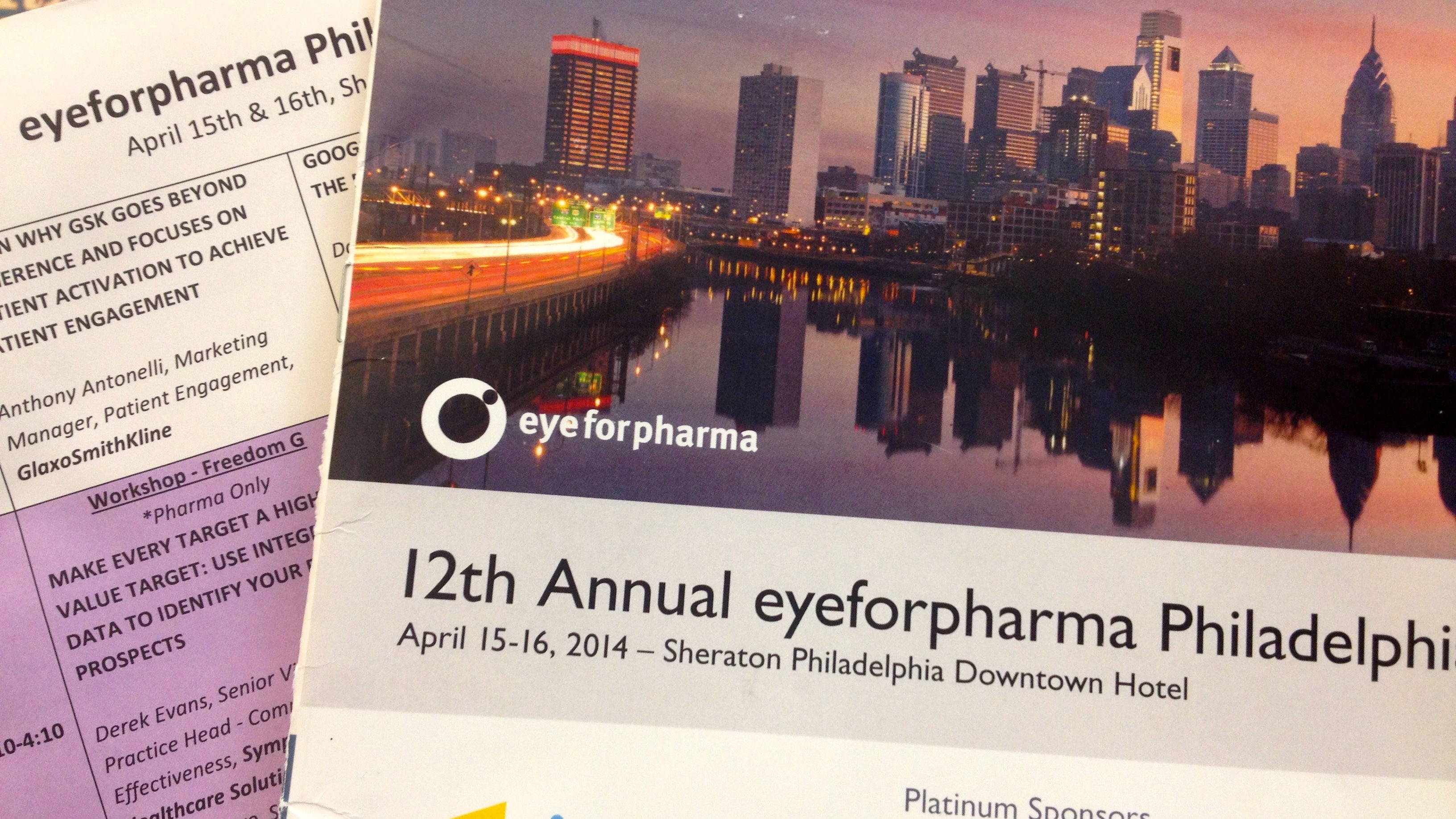Dispatch from a Philly pharma conference
Listen
(Zack Seward
A pharma conference, eyeforpharma 2014, was in Philly this week, drawing a few hundred executives to a hotel conference center downtown.
The general vibe: drab, buttoned-up. But it did offer a peek at how Big Pharma wants to see itself.
Amid a heap of contenders, there even emerged a buzzword of the moment: “patient-centricity.”
Roughly, it means thinking in terms of improved health outcomes for patients, rather than just about the next pill to hit the market.
But why the term is having its moment now is part of a bigger story: Big Pharma is at a crossroads.
Reinvention
Pharma companies tend to be guarded with the media, even voicing outright disdain at one panel. So I pulled aside Soeren Mattke for a few questions. He’s a scientist at the nonprofit research firm RAND Corporation who led a conference track here about how pharmaceutical companies can identify “Value Beyond the Pill.”
“They know that their traditional business model is under pressure, and they know that they need to evolve,” Mattke said. “And, at the same time, we know that health care per se isn’t particularly well organized and delivered.”
What Mattke is saying is that the last 10 years or so have not been kind to large pharmaceutical companies. They’re starting to feel out new opportunities across the health-care landscape — in place of what worked before.
“The initial blockbuster model was you made a drug that cost about $100 and you sold it to a million patients,” said Mattke.
Think Lipitor®, Singulair®, stuff for common conditions, stuff with the hushed side effects at the end of the commercial.
Those profit-soaked glory days of branded blockbuster drugs are coming to a close — because their patents have fallen off “the patent cliff,” generics have caught up in potency and consumers are more skeptical.
So now what?
“So companies now look at targeted drugs,” said Mattke, “and those are drugs that cost more like $100,000 and are applied to maybe 1,000 patients.”
See what he did there? An inversion of the blockbuster model, to the point where now a remarkable new hepatitis C drug costs, literally, a thousand dollars a pill. The price tag for a typical course of treatment is at least $84,000.
“And that is currently their business model,” Mattke says of the pharmaceutical industry’s current approach to niche treatments. “That’s currently sustaining their profits, but in the long-run that is not sustainable.”
That’s because big payers — insurance companies, Medicare — are likely to say, enough is enough, Mattke says. The thousand-dollar pill may be a tipping point.
Which gets us back to our crossroads, and our shiny new buzzword.
New focus
“The common theme is everything should be patient-centric,” said Eva Mitchell, a vice president at the Bucks County-based Ashfield Healthcare, standing in the eyeforpharma exhibitor hall.
Here’s her take on patient-centricity: “Everything that pharmaceutical companies do — from clinical development, to getting a product on the market, to working with insurance companies and the government — it shouldn’t be about the profits; it should be all about better patient care,” Mitchell said.
“I’m hearing way too much about patient centricity. Nobody really knows what that is,” said RAND’s Mattke, with a chuckle. “I generally dislike buzzwords, I think they’re mostly created by vendors and consultants and then they’re slapped onto everything.”
I remind him: there are plenty of vendors and consultants here.
“It’s a pharma conference and there’s still money to be made, so I’m not surprised,” he replied.
But really, Mattke says, patient-centricity isn’t a bad thing. It means pharma companies are taking consumer needs to heart. Changing business realities are forcing them to rethink who they are actually serving.
“In the past, basically, the physician was the client,” Mattke said. “So all communication, all material, all marketing was directed towards the physician and there was just the expectation that people would take their pills as prescribed.
“I think now companies are waking up to the fact that the actual client is the patient,” he added.
That means more thought will be devoted to helping patients on the journey that life-altering diseases can represent. It means services, mobile apps, YouTube commercials — are all directly, indirectly or not-at-all related to a company’s medicines.
Whether it means patients like you and me want that thought lavished on us … that’s for another conference.
WHYY is your source for fact-based, in-depth journalism and information. As a nonprofit organization, we rely on financial support from readers like you. Please give today.



